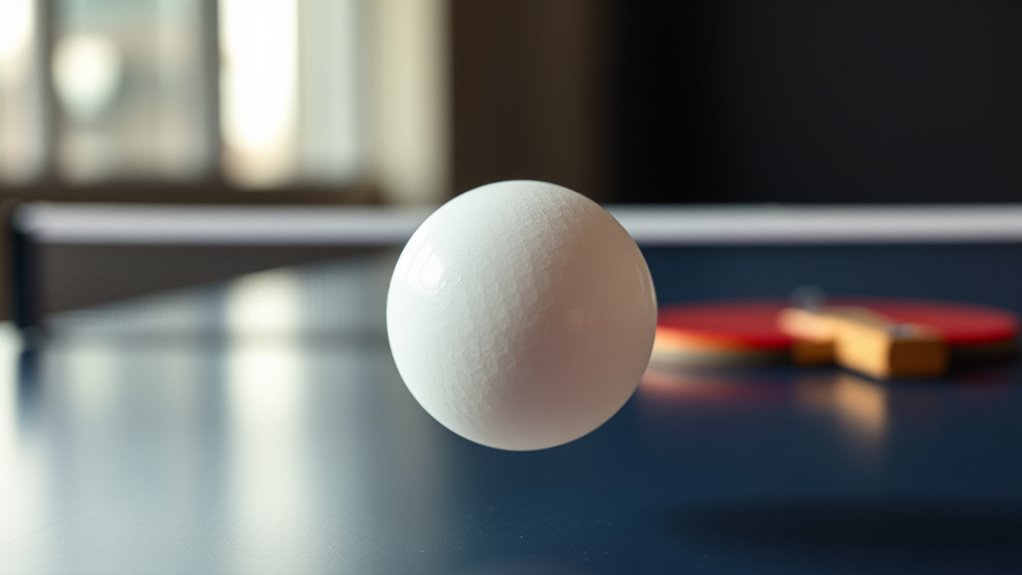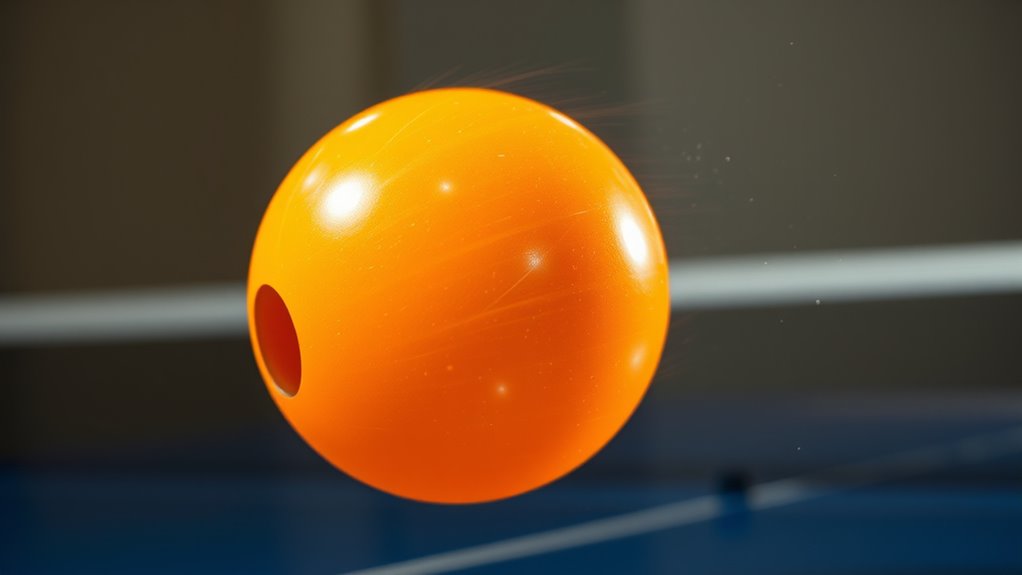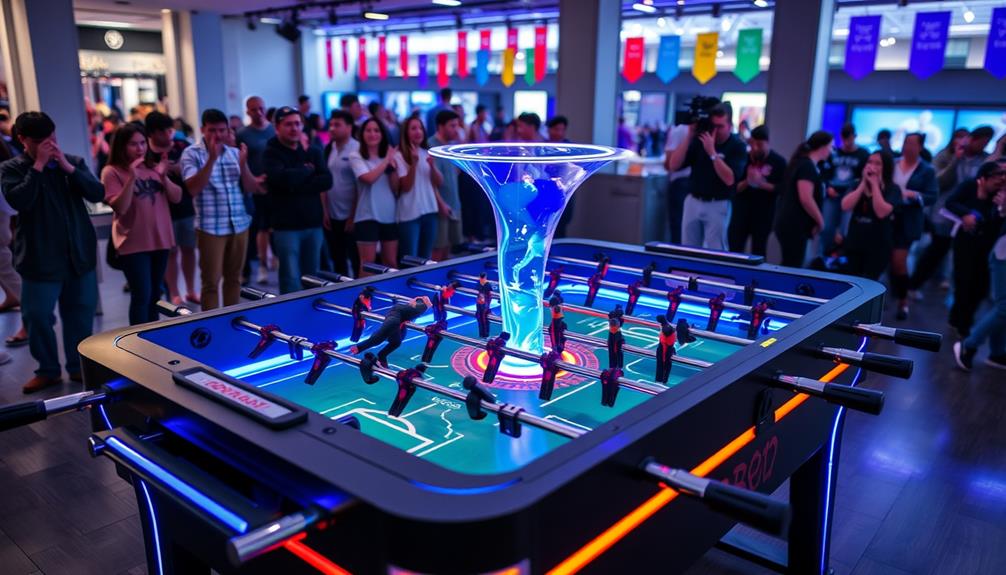Understanding ping-pong spin physics helps you control and counter shots better. Spin is created by brushing the ball with different racket angles, producing topspin, backspin, or sidespin, which affect its trajectory and bounce. Mastering how spin wobbles the ball and influences its curve allows you to surprise opponents and improve your shots. Keep practicing your technique, and you’ll discover more ways to use spin effectively for better gameplay.
Key Takeaways
- Spin in table tennis is generated by brushing the ball with the racket at specific angles.
- Different spins (topspin, backspin, sidespin) affect the ball’s trajectory and bounce differently.
- Racket grip and angle influence how much and what type of spin can be produced.
- Spin causes the ball to wobble and curve, making shots harder to predict and return.
- Consistent practice with racket control helps beginners master spin techniques effectively.
The Basics of Spin in Table Tennis

Understanding spin in table tennis is essential because it directly affects how the ball behaves during rallies. To grasp the basics, you need to consider spin measurement, which tells you how much spin you’re imparting on the ball. Your racket grip plays a vital role here; a penhold or shakehand grip influences how easily you generate spin. When you brush the ball’s surface with the racket, you create different types of spin—topspin, backspin, or sidespin—depending on the angle and motion. Consistent grip and racket angle help produce controlled spin, making your shots more effective. Additionally, understanding the physics of spin can help you refine your technique and increase your control. By mastering these fundamentals, you’ll gain better control over the ball’s movement, setting you up for more advanced techniques and strategic play.
How Spin Affects the Ball’s Trajectory

Spin dramatically influences the ball’s flight path by altering its trajectory and bounce. When you generate spin, it causes the ball to wobble due to spin induced wobbling, making its path less predictable. As the ball moves, spin decay effects gradually reduce the spin, affecting how it bounces off the table or paddle. This wobbling can make shots harder to read and return. The spin’s influence on trajectory means you’ll notice curves and dips during flight, especially with heavy spin. Understanding these effects helps you better control your shots. Here’s a quick overview:
| Effect | Description |
|---|---|
| Spin induced wobbling | Causes unpredictable wobble during flight |
| Spin decay effects | Gradual loss of spin over time |
| Trajectory changes | Curving and dipping due to spin |
Additionally, mastering how to manipulate spin allows players to enhance their control and surprise opponents with unpredictable shots.
Common Types of Spin and Their Characteristics

In ping-pong, players use different types of spin to manipulate the ball’s movement and create strategic advantage. The main types include topspin, backspin, and sidespin, each with unique effects on the ball’s trajectory. Spin mechanics determine how the ball responds to contact, affecting speed and direction. Equipment influence plays a role too; a racket’s rubber surface and grip can enhance or reduce certain spins. Topspin causes the ball to dip quickly and bounce forward, making it harder for opponents to return aggressively. Backspin creates a floating or lifting effect, slowing the ball and causing it to stay low after bouncing. Sidespin, combined with other spins, can curve the ball sideways, confusing your opponent. Understanding these common spin types helps you control play and develop effective strategies. Additionally, mindfulness techniques can improve focus and precision during gameplay, giving you a mental edge.
Techniques to Generate Spin During Play

To generate spin effectively during a match, you need to master specific racket techniques that manipulate the ball’s contact point and angle. One key method is using serve variations to add spin right from the start, adjusting your racket angle to produce different effects like topspin or sidespin. For example, tilting the racket forward or sideways changes how the ball contacts the rubber surface, creating varying spin types. During rallies, controlling your racket angle allows you to impart spin on the ball as you hit it, making returns more difficult for your opponent. Consistently practicing these techniques helps you develop a feel for how racket angles influence spin. Proper racket control is essential for effective spin generation, allowing you to vary your shots strategically. By focusing on precise contact points and adjusting your racket, you’ll improve your ability to generate and control spin during play.
Tips for Mastering Spin Shots

Mastering spin shots requires precise control over racket angle and contact point. To improve, focus on consistent technique and proper equipment maintenance. Regularly check your paddle for wear and clean the rubber surfaces to ensure ideal grip. Practice varying your racket angle to generate different spins, and pay attention to contact point placement for maximum effect. Incorporate scoring strategies, such as mixing spin shots with flat hits, to keep your opponent off-balance.
- Maintain your paddle for reliable spin production
- Experiment with different racket angles during practice
- Focus on precise contact points to execute effective spins
- Use spin shots strategically to influence scoring and rally control
Frequently Asked Questions
How Does Paddle Material Influence Spin Generation?
The paddle surface and material durability directly influence how much spin you can generate. A rougher surface helps grip the ball better, creating more spin, while smoother paddles produce less. The material of the paddle impacts its durability; high-quality materials last longer and maintain their grip over time. Choosing the right surface and durable material allows you to control spin more effectively, improving your overall gameplay.
Can Beginners Reliably Control Different Types of Spin?
You can start learning to control different types of spin, but it takes practice. When you focus on ball contact, you develop better spin consistency. By adjusting your paddle angle and stroke, you’ll notice improvements in controlling topspin, backspin, or sidespin. Although beginners might not master perfect spin right away, consistent practice helps you gain confidence and gradually refine your ability to manipulate various spins effectively.
What Are Common Mistakes When Applying Spin in Matches?
When applying spin in matches, you often make technique errors like not brushing the ball properly or using too much wrist, which can reduce control. Equipment mismatches, such as using a racket with the wrong grip or rubber, also hinder your spin effectiveness. To improve, focus on proper technique and select equipment suited to your style. Avoid rushing your shots, and practice consistently to develop better spin control during matches.
How Does Rubber Choice Affect Spin Potential?
Did you know that choosing the right rubber can increase spin potential by up to 30%? Your rubber adhesive plays a vital role, as it affects grip and spin generation. A paddle grip with softer rubber offers more control and spin, while harder rubbers provide speed. Selecting the appropriate rubber based on your playing style can markedly boost your spin, making your shots more unpredictable and difficult for opponents to return.
Are There Any Health Considerations When Practicing Spin Techniques?
When practicing spin techniques, you should consider health safety and injury prevention. Make sure to warm up properly before playing to avoid strains or sprains. Pay attention to your posture and grip to prevent repetitive strain injuries. Take breaks regularly to reduce fatigue, and listen to your body. Proper technique and equipment help minimize risks, allowing you to enjoy the game safely and improve your skills without health concerns.
Conclusion
Mastering spin in table tennis is like learning to dance with the ball, turning every shot into a graceful movement. As you develop your skills, you become the artist painting curves and illusions on the table’s canvas. With patience and practice, you’ll wield spin like a brush, transforming simple rallies into a vivid masterpiece of control and deception. Embrace the journey, and soon you’ll craft your own symphony of spin, mesmerizing your opponents with every stroke.









